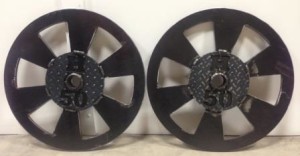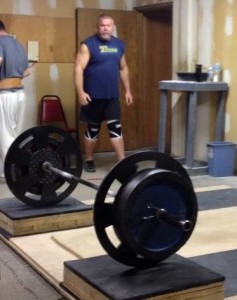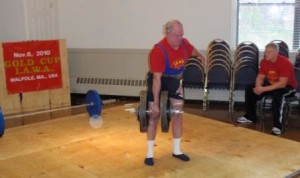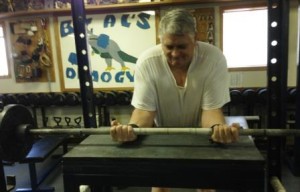by John McKean
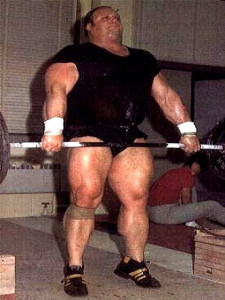
Serge Reding
Leaping very high into the air, toes pointed perfectly, crisp coordinated form, with pinpoint precision and speed, I’d have awarded a perfect score of “10” to the would-be ballerina!! Well, at least, to this 309 pound “ballerina” who possessed over 20” bulging, ballistic-powered calves!! You see, I’d just witnessed the phenomenal, densely muscled Serge Reding perform a textbook squat snatch with an extremely heavy barbell (he eventually snatched 402 pounds!) at the 1970 World Championships in Columbus, Ohio. He was obviously a pleased and happy man during this victory jump, and almost outdid the legendary Alexeev for the overall title!
My excitement was on a different level. Never had I seen such pure pulling power as developed by this 5’7” human tank. Nor anyone, anywhere so thickly muscled, as the obvious outcome of longtime pulling dedication! Heck, later, after that day’s lifting, a Mr. World, or some such physique event, was scheduled with featured competitors Olivia, Schwartzenegger, Columbu, etc. However, after being absolutely blown away by Serge Reding, I told my wife we were heading back home immediately (I had highly motivated TRAINING to do!) because NOBODY, no matter what titles held, could look as physically and functionally impressive as the Belgian Blockbuster!!
Upon further reading, it seems ole Serge also once deadlifted 771 pounds – with no training whatsoever on that lift! Hmmm, maybe I should have done more olympic lifting in my teens, rather than jumping right into powerlifting. Still, it proved then that it’s never too late to add a few pulling movements. But it was much later, as a master’s age lifter, that the wonderful world of all-round weightlifting competition (I.A.W.A.) provided a huge variety of on ground and off ground pulls. Events such as straddle lifts, hacks, continental cleans, hang snatches, single arm swings and various positioned one handed heaves, etc., etc., went a long way toward making up for a misspent youth!!
Yet it wasn’t until former U.S.A.W.A. President, Cleveland’s late, great Howard Prechtel, showed me a unique, relatively obscure lift favored by old timer Herman Goerner, that my old bod started to “feel” much how Serge Reding “looked”! That is, upon performing this platform-up pull, every muscle fiber and tendon went into serious tension mode; a rich feeling during the delightful strain suggesting my body was being turned inside out!
The pull in question is the two barbell deadlift. Yep, an olympic barbell at right and left, hook gripped and grabbed from the exact centers, then a slow, torturous stand up. Certainly, SLOW motion is a key due to balance issues, but the nature of the lift also supplies a sustained TOTAL BODY ISOMETRIC contraction of everything from toes to nose for support! I’ve long maintained that ALL max weight lifting works the musculature entirely, through the iso effect of holding heavy barbells, and that ONE heavy lift is superior to any long term scheme of sets & reps!! You’ll have to actually try a near limit two barbell deadlift to understand, but literally ONE rep yields a very efficient, entire body “flush”! (Please forgive the bodybuilding terms!! Yet just as Reding displayed, the ultimate form of “posing” is under the duress of crimson-faced struggling with something extremely heavy! His 21” arms certainly looked sufficiently “flexed” with the the eye-popping overhead pressing performance of an official 502 pounds! Check Youtube).
Why not go to an easier loading trap bar or 2 dumbbell deadlifts? Well, one can position himself far better with 2 moveable barbells to the sides; while a trap bar offers a fixed hold and seems so far more restricting. Personally, I can always achieve higher poundage with two barbells than a trap bar, or with clumsier dumbbells. Plus the grip work is intense, and it’s a genuine thrill to pull & hold TWO heavily loaded 7 foot bars!
These days, in early middle age (70!), I often think I could just live with the TBD alone as a complete exercise program, just working up to a top single. Yeah, a few other favorite contest exercises are still retained because there’s always all-round meets approaching, but none of those secondary movements provide that one rep “pump” instilled by the iso effect of hefting 2 big bars. I swear that the lift actually “irons out,” for the duration of supporting it, all the “old man body wrinkles” life has somehow given me!
Garage trainees, try some! You are certainly in a better place to load and pick up 2 parallel bars than in a commercial gym or even within the friendlier confines of a competition oriented “pit.” Trust me, you don’t want the unnecessary attention when devoting time to train this rather strange movement! Nor do you deserve the fearful stares as super effort 2 bar deadlifts threaten to explode your face and neck when all the hidden veins and tendons come springing forth!
